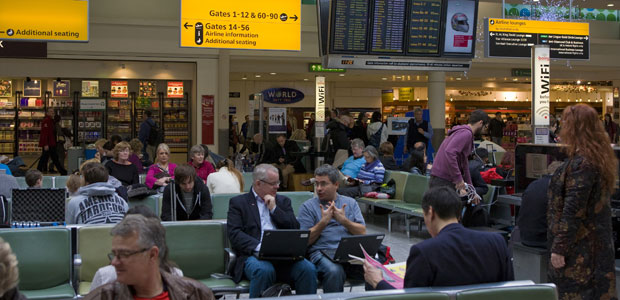Flight disruption at Heathrow again – will it ever change?
With hundreds of flights cancelled at Heathrow because of the freezing weather, Channel 4 News looks at whether a solution is possible.

Heathrow’s owner BAA is adamant it did a good job. But North West England MEP Brian Simpson, who chairs the European Parliament’s transport committee, told Channel 4 News a small quantity of snow should not have grounded this number of flights – and Simon Calder, travel editor of the Independent, said the airport’s flight schedule should be reduced.
After December 2010, when days of harsh weather meant the airport nearly ground to a halt and thousands of passengers were forced to camp overnight in terminals, BAA knew action was needed.
2010 chaos
Back then, at the height of the chaos on 19 December, it was only able to handle around 20 flights. This time, albeit in less harsh conditions, hundreds completed their journeys, although that is little solace to those passengers who were inconvenienced.
BAA has invested in snow-clearing equipment, but it was being prepared that ensured the disruption to people’s travel plans was not worse. Realising snow was on its way, the company liaised with airlines and air traffic control and a more pro-active approach was adopted.
The company says: “We took the decision with airlines and air traffic control yesterday to reduce the flight schedule in advance. By cancelling flights in advance, airlines have been able to rebook some people on to flights that are departing, and passengers have had better quality information about whether they can fly or not.”
Why does three inches of snow cause 50 per cent of flights to be cancelled? It shouldn’t happen. Brian Simpson MEP
Of course, Heathrow was fortunate that only a couple of inches of snow fell over a matter of hours, rather than days. It was also the ‘right kind of snow’: dry and easy to shift, rather than wet and prone to freeze.
Full capacity
Heathrow is the busiest airport in Europe in terms of passenger numbers and BAA stresses that it is operating at near full capacity (99.2 per cent).
For safety reasons, it can only cope with a set number of flights a day because distance between planes needs to be observed. It has two runways, in comparison with Europe’s other busiest airports, Paris CDG, Frankfurt and Amsterdam Schipol, which have twice as many.
BAA wanted to build a third runway to cope with its capacity problems at Heathrow, but the government turned it down. It is also worth pointing out that on Saturday, dozens of flights were also cancelled at Schipol, Europe’s fourth busiest airport.
Europe
According to a consultant’s study for the European Commission, six airports are operating at what it describes as full capacity: Heathrow, Gatwick, Frankfurt, Dusseldorf, Paris Orly and Milan Linate.
In terms of numbers of hours per day when the airports are at full stretch, Heathrow and Gatwick are the most saturated, with Heathrow described as ” full all day, year-round”.
On current trends, says the study, 19 airports will reach saturation point by 2030, meaning possible delays for half of all passenger and cargo flights.
Eurocontrol, Europe’s air traffic control service, says: “Given the expected traffic evolution, Europe will face an ever growing gap between the available capacity and demand. This is referred to as the ‘capacity crunch’. If current capacity levels are not significantly increased, it is estimated that over 60 European airports will be heavily congested and the top 20 airports will be saturated at least 8-10 hours per day by 2025.”
BAA says it cannot cope with its usual schedule in the snow because runways need to be cleared and planes de-iced. There is no way it can be business as usual if there is the slightest glitch.
Gatwick
But at Gatwick, only nine flights were cancelled over the weekend, with 1,200 unaffected. During its busiest period at this time of year, the morning, capacity stands at 90 per cent.
Unlike Heathrow, it only has one runway, but coped better. The reason, says BAA, is that Heathrow was plagued by heavy fog on Sunday, while there were clear skies at Gatwick.
So what is the answer to Heathrow’s problems?
If you’re flying into Heathrow in the winter, then build 24 hours into your plans. Simon Calder, travel journalist
North West England MEP Brian Simpson, who chairs the European Parliament’s transport committee, told Channel 4 News: “We can’t whinge and complain when Heathrow has problems when we have a drop of three inches of snow and then restrict it and not allow it to expand. We can’t have our cake and eat it.”
But Mr Simpson said it was wrong that a few inches of snow grounded nearly half of Heathrow’s flights. “Why does three inches of snow cause 50 per cent of flights to be cancelled? It shouldn’t happen. If this is going to happen every time there’s snow, we have to have planning to try to put a stop to this.”
‘Inevitable’
Simon Calder, travel editor of the Independent, told Channel 4 News that disruption caused by the weather was “an inevitable part of life at Heathrow.”
He said Heathrow’s schedule was “over-ambitious” and should be reduced by at least 5 per cent, which would make the airlines “squeal”, but could offer some respite.
He believes a third runway is not the answer because it would soon fill up, and that it would be better for some flights to use Gatwick instead of Heathrow.
The passenger experience? “Part of it is training the passenger. If you’re flying into Heathrow in the winter, then build 24 hours into your plans. If your flight is discrupted and you end up with 24 hours in Barcelona or Scotland, you can shout yipee for the free holiday, rather than oh my God, the world is ending.”




